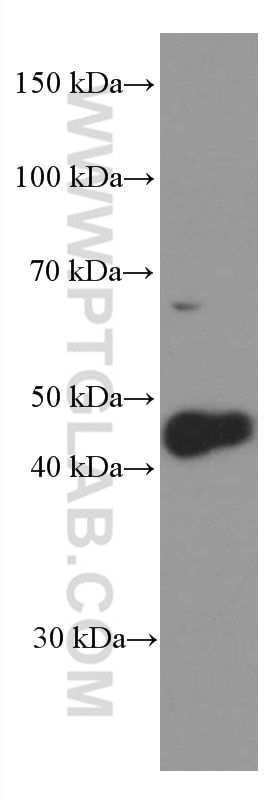Tested Applications
| Positive WB detected in | HL-60 cells, K-562 cells |
Recommended dilution
| Application | Dilution |
|---|---|
| Western Blot (WB) | WB : 1:1000-1:8000 |
| It is recommended that this reagent should be titrated in each testing system to obtain optimal results. | |
| Sample-dependent, Check data in validation data gallery. | |
Product Information
66436-1-Ig targets NFE2 in WB, ELISA applications and shows reactivity with human samples.
| Tested Reactivity | human |
| Host / Isotype | Mouse / IgG1 |
| Class | Monoclonal |
| Type | Antibody |
| Immunogen | NFE2 fusion protein Ag1570 Predict reactive species |
| Full Name | nuclear factor (erythroid-derived 2), 45kDa |
| Calculated Molecular Weight | 41 kDa |
| Observed Molecular Weight | 45 kDa |
| GenBank Accession Number | BC005044 |
| Gene Symbol | NFE2 |
| Gene ID (NCBI) | 4778 |
| RRID | AB_2881806 |
| Conjugate | Unconjugated |
| Form | Liquid |
| Purification Method | Protein A purification |
| UNIPROT ID | Q16621 |
| Storage Buffer | PBS with 0.02% sodium azide and 50% glycerol , pH 7.3 |
| Storage Conditions | Store at -20°C. Stable for one year after shipment. Aliquoting is unnecessary for -20oC storage. 20ul sizes contain 0.1% BSA. |
Background Information
The transcription factor p45 nuclear factor-erythroid-derived 2(NFE2) is one component of the NF-E2 complex that essential for regulating reythroid and megakaryocytic maturation and differentiation. It also plays crucial roles in erythroid and megakaryocytic lineages. NFE2 recognizes the TCAT/C sequence of the AP-1-like core palindrome present in a number of erythroid and megakaryocytic gene promoters, and acts as a activator. And it may has a role in all aspects of hemoglobin production from globin and heme synthesis to procurement of iron.
Protocols
| Product Specific Protocols | |
|---|---|
| WB protocol for NFE2 antibody 66436-1-Ig | Download protocol |
| Standard Protocols | |
|---|---|
| Click here to view our Standard Protocols |





